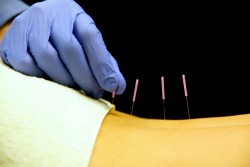Acupuncture/Meridian Therapy and Dry Needling: Similarities and Differences
Jan 08, 2020

What are the differences between acupuncture and trigger point dry needling, or are they the same thing? This is a question that we at our clinic are often asked.
Acupuncture
Acupuncture is an ancient science and healing art that most authorities agree has been around about 5,000 to 7000 years. Acupuncture principles have been used successfully to treat both pain and dysfunction in the body by utilizing very slender needles placed in the skin in various locations that are known to affect a body part, organ or a function.
Early Asian physicians discovered that there is an energy network traversing on or just below the surface of the skin which communicates from the exterior to the internal organs and structures from over 1,000 “acupoints” on the body. This energy works in harmony with the body’s circulatory, nervous, muscular, digestive and other systems of the body. When this vital energy becomes imbalanced, weakened or blocked, that particular organ system or tissue suffers and will eventually produce symptoms and/or pain reflecting dysfunction from that area or that organ system affected.
Acupuncture principles can be employed without the use of needles while treating the body. Meridian therapy is the accepted term we use to describe these other forms of therapy that stimulate an acupuncture point without the use of a penetrating needle. These methods include: pressure/massage, electronic stimulation, and laser stimulation.
In short, the goal of acupuncture is to restore normalcy to the body’s energy field by stimulating a combination of specific acupuncture points through a number of different applications, the needle being just one of them.
Trigger Point Dry Needling (TPDN)
Dry needling (also known as Trigger Point Dry Needling) is a physical intervention that utilizes a filiform needle to stimulate trigger points which are usually located within muscles of the body. This method of treating the body does not alter the energy network of the body like acupuncture, and is mostly concerned with normalizing muscle function and balance and reducing pain in the musculoskeletal system.
A trigger point is a “hyper-irritable”, painful spot in a tight band of muscle. This spot is tender when pressed and can refer pain away from the painful muscle. A trigger point develops within a muscle when the muscle becomes involuntarily tight either through poor posture, injury, overuse, or other causes. It sustains a contraction leading to maximal energy demand and decreased circulation in the muscle. This, in turn, leads to increased pain generation through the release of certain chemicals in the muscle and through sensitizing nerve fibers into active response in the area producing more contraction. Stimulation of these trigger points using a slender needle has been found to be very helpful in reducing the response of these nerve fibers, reducing muscular contraction, and relieving pain in the muscles.Both methods of treatment are effective in addressing dysfunction and pain in the body.
Both treatments can utilize a slender needle. TPDN is used often in our clinic for a variety of musculoskeletal complaints ranging from muscle strain in the back, legs, knees, elbows,shoulders, necks, as well as pain in the feet, hands and TMJ. Acupuncture is utilized in our office to treat pain in the same areas above, as well as for more systemic conditions or health concerns like neuropathy, hormonal problems, and headaches, as well as a variety of other conditions.
If you are considering trying acupuncture or trigger point dry needling to address your pain or other health concerns, give us a call and we’d be happy to discuss these possible treatment options with you.
See also, video found on YouTube.
Tags:
backpain, Effective, Chiropractic, Quality Care, musculoskeletal, dry needling, trigger point dry needling, pain, headaches